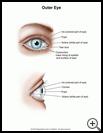
Bleeding in the White of the Eye (Subconjunctival Hemorrhage)
What is bleeding in the white of the eye?
If a small blood vessel breaks in the white part of the eye, the blood makes part of the white of the eye bright red. This is also called a subconjunctival hemorrhage. There is usually a patch or line of redness on the white part of the eye. The redness can increase over 24 to 48 hours, especially if you are taking aspirin or blood thinners. Usually, it clears up by itself in a week or two, like a bruise on the skin.
What is the cause?
A direct injury to the eye can cause bleeding in the white of the eye. It can also be caused by coughing, vomiting, sneezing, or a bowel movement. Being on blood thinners such as aspirin or warfarin may increase the risk. However, most of the time, there is no clear cause for it.
What are the symptoms?
Your child’s eye will be red. Some children have a mild scratchy feeling in the eye. It should not affect your child’s vision.
How is it diagnosed?
Your healthcare provider will look at your child’s eye. Usually no tests are needed. If it happens to your child a lot, a blood test may be done to check for a bleeding problem.
How is it treated?
Usually, no treatment is needed. The blood becomes absorbed over time and the eye becomes clear again. The scratchy feeling can be treated with artificial tears (eyedrops).
How long will the effects last?
In most cases, the redness in your eye goes away in 1 to 3 weeks. The affected part of the eye often turns yellow before it turns white again.
How can I take care of my child?
- Follow the treatment plan.
- Keep all appointments for provider visits or tests.
Last modified: 2011-10-11
Last reviewed: 2011-10-10

